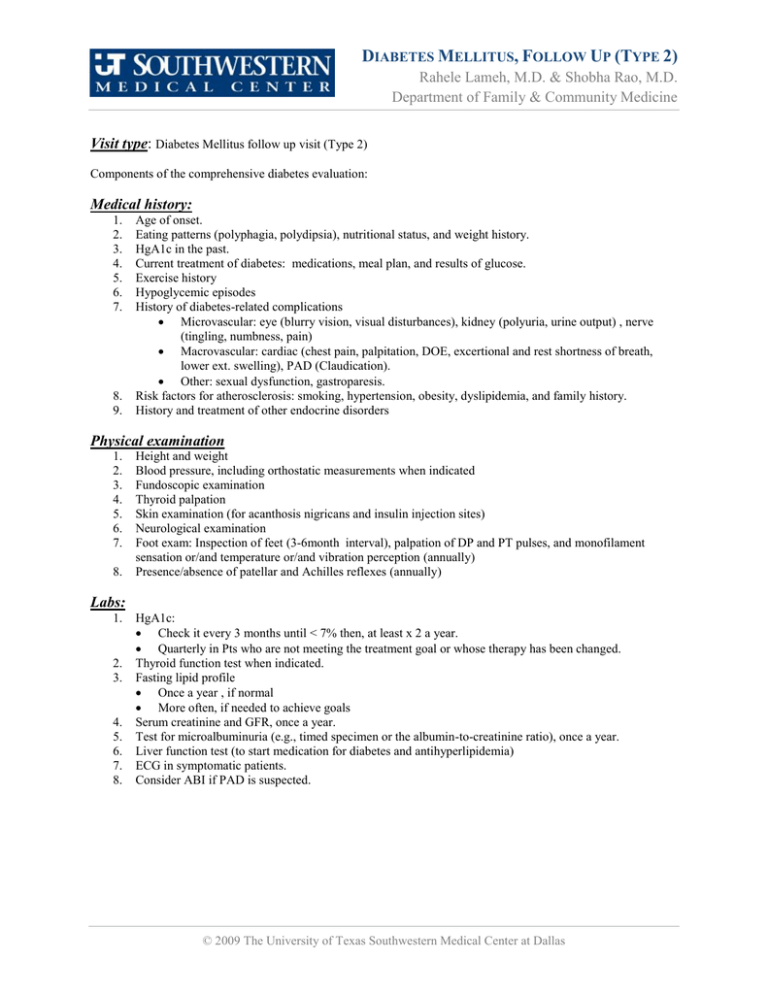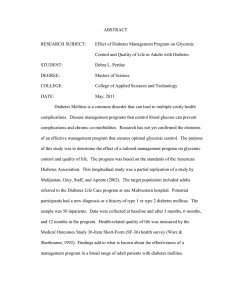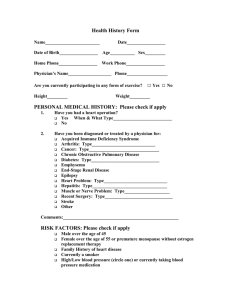Diabetes Mellitus, Follow Up (Type 2)
advertisement

DIABETES MELLITUS, FOLLOW UP (TYPE 2) Rahele Lameh, M.D. & Shobha Rao, M.D. Department of Family & Community Medicine Visit type: Diabetes Mellitus follow up visit (Type 2) Components of the comprehensive diabetes evaluation: Medical history: 1. 2. 3. 4. 5. 6. 7. 8. 9. Age of onset. Eating patterns (polyphagia, polydipsia), nutritional status, and weight history. HgA1c in the past. Current treatment of diabetes: medications, meal plan, and results of glucose. Exercise history Hypoglycemic episodes History of diabetes-related complications Microvascular: eye (blurry vision, visual disturbances), kidney (polyuria, urine output) , nerve (tingling, numbness, pain) Macrovascular: cardiac (chest pain, palpitation, DOE, excertional and rest shortness of breath, lower ext. swelling), PAD (Claudication). Other: sexual dysfunction, gastroparesis. Risk factors for atherosclerosis: smoking, hypertension, obesity, dyslipidemia, and family history. History and treatment of other endocrine disorders Physical examination 1. 2. 3. 4. 5. 6. 7. 8. Height and weight Blood pressure, including orthostatic measurements when indicated Fundoscopic examination Thyroid palpation Skin examination (for acanthosis nigricans and insulin injection sites) Neurological examination Foot exam: Inspection of feet (3-6month interval), palpation of DP and PT pulses, and monofilament sensation or/and temperature or/and vibration perception (annually) Presence/absence of patellar and Achilles reflexes (annually) Labs: 1. 2. 3. 4. 5. 6. 7. 8. HgA1c: Check it every 3 months until < 7% then, at least x 2 a year. Quarterly in Pts who are not meeting the treatment goal or whose therapy has been changed. Thyroid function test when indicated. Fasting lipid profile Once a year , if normal More often, if needed to achieve goals Serum creatinine and GFR, once a year. Test for microalbuminuria (e.g., timed specimen or the albumin-to-creatinine ratio), once a year. Liver function test (to start medication for diabetes and antihyperlipidemia) ECG in symptomatic patients. Consider ABI if PAD is suspected. © 2009 The University of Texas Southwestern Medical Center at Dallas Diabetes Mellitus, Follow Up (Type 2) The University of Texas Southwestern Medical Center at Dallas Treatment: A. Metabolic Management: Start insulin in patient presenting with weight loss, and glucose >250 to 300 mg/dl. B. Diabetic nephropathy management: ACE inhibitors (or ARBs) Maintenance of strict glycemic Dietary protein restriction (0.8-1.0 g/kg of total body weight/d) Blood pressure control (< 130/80) C. Aspirin: Aspirin (75 to 162 mg/day) is recommended in any diabetes, age >40 years, with one additional CAD risk factor. Patient education: 1. Comprehensive Diabetes education as needed. 2. Physical Activity: at least 150 min/week of moderate-intensity aerobic physical activity and/or at least 90 min/week of vigorous aerobic exercise 3. Foot care: Avoid going barefoot, test water temperature before stepping into a bath. Trim toe nails to shape of the toe; remove sharp edges. Do not cut cuticles. Wash and check feet daily. Shoes should be snug but not tight. Socks should fit and be changed daily. – 2 – Diabetes Mellitus, Follow Up (Type 2) The University of Texas Southwestern Medical Center at Dallas 4. Education about hypoglycemic and hyperglycemic symptoms. 5. Self measurement of blood sugar by the patient: three or more times daily for patients using multiple insulin injections. (A) Less frequent in Pts who are on oral agents, or only on diet (E) Immunization: Once a year influenza vaccine. Pneumococcal vaccine, revaccination for individuals >64 years of age previously immunized. Goals: Glycemic control A1C <7.0% Preprandial capillary plasma glucose 90–130 mg/dl (5.0–7.2 mmol/l) Peak postprandial capillary plasma glucose (1-2 hrs after the beginning of the meal) <180 mg/dl (<10.0 mmol/l) Blood pressure <130/80 mmHg Lipid control o o o LDL <100 mg/dl (<2.6 mmol/l) Triglycerides <150 mg/dl (<1.7 mmol/l) HDL >40 mg/dl (>1.0 mmol/l) HDL goal for women has been suggested to be increased by 10 mg/dl. Less intensive glycemic goals may be indicated in patients with severe or frequent hypoglycemia. Current NCEP/ATP III guidelines suggest that in patients with triglycerides 200 mg/dl, the "non-HDL cholesterol" (total cholesterol minus HDL) be utilized. The goal is 130 mg/dl (121). Referrals: 1. Dilated and comprehensive eye examination by an ophthalmologist or optometrist should be repeated annually. (B) 2. Podiatry: Patients who smoke patients with foot ulcer or high risk feet (h/o prior ulcer or amputation.) 3. Refer patients with significant claudication or a positive ABI for further vascular assessment and consider exercise, medications, and surgical options. (C) 4. CHD Screening tests (Stress test): in patients with 1) history of peripheral or carotid occlusive disease and 2) sedentary lifestyle whose 10-year risk of a coronary event is likely to be >10%, age >35 years, and plans to begin a vigorous exercise program.). 5. Upper GI and lower GI symptom to rule out structural abnormalities. 6. Consider referral to a physician experienced in the care of diabetic renal disease when the estimated GFR has fallen to <60 ml/min per 1.73 m2 or if difficulties occur in the management of hypertension or hyperkalemia. (B) 7. Medical nutrition therapy. (If did not have before). – 3 – Diabetes Mellitus, Follow Up (Type 2) The University of Texas Southwestern Medical Center at Dallas References: Medscape Family Medicine, Standards of Medical Care for Patients With Diabetes Mellitus, from Diabetes Care . Diabetes Care 30:S4-S41, 2007DOI: 10.2337/dc07-S004, 2007 by the American Diabetes Association, Standard of Medical Care in Diabetes-2007. Rahele Lameh, M.D. Assistant Professor, Family & Community Medicine Shobha Rao, M.D. Associate Professor, Family & Community Medicine Last Reviewed: 2008 – 4 –


